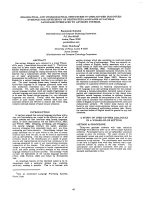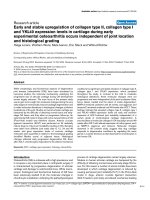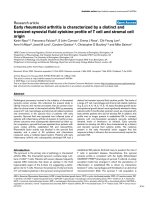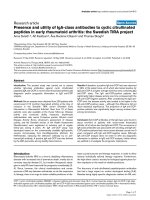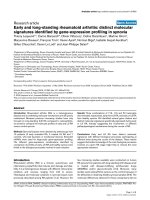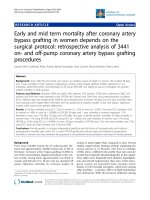Báo cáo y học: "Early and late morbidity and mortality and life expectancy following thoracoscopic talc insufflation for control of malignant pleural effusions: a review of 400 cases" potx
Bạn đang xem bản rút gọn của tài liệu. Xem và tải ngay bản đầy đủ của tài liệu tại đây (672.23 KB, 7 trang )
Barbetakis et al. Journal of Cardiothoracic Surgery 2010, 5:27
/>Open Access
RESEARCH ARTICLE
BioMed Central
© 2010 Barbetakis et al; licensee BioMed Central Ltd. This is an Open Access article distributed under the terms of the Creative Com-
mons Attribution License ( which permits unrestricted use, distribution, and reproduc-
tion in any medium, provided the original work is properly cited.
Research article
Early and late morbidity and mortality and life
expectancy following thoracoscopic talc
insufflation for control of malignant pleural
effusions: a review of 400 cases
Nikolaos Barbetakis*
1
, Christos Asteriou
1
, Fani Papadopoulou
1
, Georgios Samanidis
1
, Dimitrios Paliouras
1
,
Athanassios Kleontas
1
, Konstantina Lyriti
2
, Ioannis Katsikas
2
and Christodoulos Tsilikas
1
Abstract
Background: Malignant pleural effusion is a common sequelae in patients with certain malignancies. It represents a
terminal condition with short median survival (in terms of months) and the goal is palliation. Aim of our study is to
analyze morbidity, mortality and life expectancy following videothoracoscopic talc poudrage.
Materials and methods: From September 2004 to October 2009, 400 patients underwent video-assisted thoracic
surgery (VATS) for malignant pleural effusion. The conditions of patients were assessed and graded before and after
treatment concerning morbidity, mortality, success rate of pleurodesis and median survival.
Results: The median duration of follow up was 40 months (range 4-61 months). All patients demonstrated notable
improvement in dyspnea. Intraoperative mortality was zero. The procedure was well tolerated and no significant
adverse effects were observed. In hospital mortality was 2% and the pleurodesis success rate was 85%. A poor
Karnofsky Performance Status and delay between diagnosis of pleural effusion and pleurodesis were statistically
significant factors for in-hospital mortality. The best survival was seen in breast cancer, followed by ovarian cancer,
lymphoma and pleural mesothelioma.
Conclusions: Video-assisted thoracoscopic talc poudrage is an effective and safe procedure that yields a high rate of
successful pleurodesis and achieves long-term control with marked dyspnea decrease.
Introduction
Pleural effusions are a common and devastating compli-
cation of advancedmalignancies. These effusions most
commonly occur with lung, breast, ovarian cancer and
lymphoma, with breast and lung malignancies alone
accounting for approximately of 75% of these effusions
[1].
In patients who develop progressive pleural effusions
producing dyspnea and cough, quality of life is affected.
Patients with symptomatic effusions may benefit from
pleurodesis to relieve dyspnea and to prevent reaccumu-
lation of pleural fluid.
The purpose of this study was to determine the long
term efficacy and safety of pleurodesis by thoracoscopic
talc poudrage in malignant pleural effusions.
Materials and methods
All patients with symptomatic malignant pleural effusion
referred to the Thoracic Surgery service of Theagenio
Cancer Hospital for thoracoscopic pleurodesis were eligi-
ble to participate in this study. Inclusion in the study
required documentation of a malignant pleural effusion
and good general condition (capability to care for them-
selves). The diagnosis of pleural carcinomatosis was
established by positive pleural fluid cytology on thora-
centesis or evidence of malignancy on pleural biopsy
prior to referral. Patients with significant loculated effu-
sions or trapped lung after drainage were excluded from
* Correspondence:
1
Thoracic Surgery Department, Theagenio Cancer Hospital, A. Simeonidi 2,
T
hessaloniki, 54007, Greece
Full list of author information is available at the end of the article
Barbetakis et al. Journal of Cardiothoracic Surgery 2010, 5:27
/>Page 2 of 7
the study. All patients underwent preoperative bronchos-
copy to exclude endobronchial obstruction and chest
computed tomography scan.
Thoracoscopy was performed under general anesthesia
in all patients. A 10-mm camera port and one or two
instrumentation ports were inserted. We used a zero
grade optical camera to assess the pleura and the lung
surface. The pleural effusion was carefully aspirated and
fibrinous adhesions were divided with diathermy. At least
four different biopsy specimens were obtained from
abnormal areas and a frozen section was performed. The
degree of lung expansion was ascertained with sustained
positive pressure ventilation (20-30 cm H2O). Pleurode-
sis was performed by thoracoscopic insufflation of sterile
asbestos-free talc powder (6 gr) in all patients regardless
the extent of disease. At the end of the procedure one
chest tube was left in situ. The drain was removed when
the volume collected remained under 200 ml for two con-
secutive days.
Morbidity included all complications occurring during
hospitalization only. In-hospital mortality included both
those patients who died within first 30 days and those
who died later but during the same hospitalization.
Three-month mortality included those patients who died
within 90 days after surgery. Follow up was obtained by
periodical clinical examination combined with chest radi-
ography and/or thoracic ultrasound. The failure of pleur-
odesis was defined by a need for repeat thoracentesis or
tube thoracostomy to drain a recurrent pleural effusion
during the 3 months after pleurodesis.
Univariate analysis was used for continuous variables
associated with In-Hospital mortality and 3-Month Mor-
tality. Data are mean ± standard deviation. Differences
were considered significant with p values of p < 0.05.
The study was approved by the Investigational Review
Board at Theagenio Cancer Hospital and informed con-
sent was obtained from all eligible patients.
Results
From September 2004 to October 2009, 400 patients
underwent video-assisted thoracic surgery (VATS) for
recurrent malignant pleural effusion. The characteristics
of patients and the underlying malignant disease are
shown in Tables 1 and 2 respectively.
The average duration of VATS talc pleurodesis com-
bined with pleural or lung biopsies was 26 minutes (± 6
min). The conversion rate to thoracotomy was 0%. No
operative deaths and no intraoperative major complica-
tions were occurred. Three hundred and ninety three
patients were weaned from mechanical ventilation in the
operating theatre. Seven patients were transferred intu-
bated to the intensive care unit.
Postoperative complications occurred in 66 patients
and are shown in Table 3. Our rates were rather low, with
the only exception of transient air leak (9%). This compli-
cation could be attributed not only to lung or visceral
pleura biopsies but also to the rupture of necrotic tumor
nodules at the moment of lung reexpansion. Persistent air
leak was managed successfully through a carefully
applied progressive suction for usually 48 hours with an
exception of one case. Under no circumstances was talc-
induced ARDS observed.
The average duration of chest drainage was 6 days
(range: 2 - 10). The average duration of postoperative
hospitalization was 7 days (range: 4 - 9) for the patients
without postoperative complications versus 16 days
(range: 7 - 40) for the patients with postoperative compli-
cations.
Eight patient deaths (8/400, 2%) occurred during hospi-
talization. The cause of death was pneumonia in 3
patients, pulmonary embolism in 2 patients, myocardial
infarction in 2 patients and septic shock in 1 patient. The
death rate within 3 months after pleurodesis was 15/400
(3.7%). Factors adversely affecting in hospital mortality
and 3-month mortality included age, Karnofsky Perfor-
mance Status and delay between diagnosis of pleural effu-
sion and pleurodesis. The last two factors were found to
be statistically significant (Table 4).
The median duration of follow up was 40 months
(range 4-61 months). The post-pleurodesis average sur-
vival according to primary malignancy is shown in Table
5. The best survival was seen in breast cancer, followed by
ovarian cancer, lymphoma and pleural mesothelioma.
Three hundred and forty patients (340/400 - 85%) had a
lasting pleural symphysis until death or the date of last
follow up. The exact relation between primary malig-
nancy and success rate is indicated in Table 6.
Discussion
Malignant pleural effusions are one of the leading causes
of recurrent pleural effusions worldwide, with an esti-
mated annual incidence of 150.000 cases in the United
States [2]. Dyspnea that arises from pleural effusion
impacts considerably the quality of life. Thoracentesis is
an essential first step but may only provide temporary
Table 1: Characteristics of the study population (n: 400).
CHARACTERISTICS Median (range)
Age (y) 63.2 (21-78)
Sex (male/female) 261/139
Weight loss > 5 kg 84 pts
Karnofsky Status 50 (10-90)
Barbetakis et al. Journal of Cardiothoracic Surgery 2010, 5:27
/>Page 3 of 7
relief and can be associated either with the recurrence of
pleural effusion (90% of patients will develop recurrence
of effusion within 30 days) or to iatrogenic pneumotho-
rax, pleural fluid loculation or contamination with subse-
quent empyema [3]. Simple chest tube drainage is also
associated with recurrence of pleural effusion (80% of
patients within 30 days after removal of the tube) [4].
Chest tube drainage and chemical pleurodesis is the gold
standard of care for malignant pleural effusions. Tetracy-
cline the agent used most commonly in the past, is no
longer commercially available. Many other chemothera-
peutic agents such as doxorubicin, cisplatin and cytara-
bine combination, etoposide, fluorouracil, mitomycin,
mitoxantrone have been used for sclerotherapy. In addi-
tion radioactive isotopes, corynebacterium parvum,
interferon and recombinant interleukin-2 have been
instilled in the pleural space for treatment of malignant
pleural effusions. Response rate has been variable and
less than optimal [5].
Silver nitrate 0.5% has proved to be an efficient alterna-
tive to tetracycline derivatives and talc for inducing pleu-
rodesis in experimental studies. Its efficacy has also been
proved in clinical studies. In patients with malignant
pleural effusions who received 0.5% silver nitrate or 5 g of
talc "slurry," silver nitrate was more effective in inducing
Table 2: Pathology of 400 malignant pleural effusions.
PATIENTS
MALIGNANCY No %
Non small cell lung cancer 166 41.5
Breast cancer 97 24.2
Ovarian cancer 24 6
Uterine cancer 16 4
Colon cancer 16 4
Sarcoma 14 3.5
Gastric cancer 13 3.2
Lymphoma 13 3.2
Small cell lung cancer 10 2.5
Pleural mesothelioma 10 2.5
Melanoma 7 1.7
Oesophageal cancer 4 1
Testicular cancer 4 1
Hepatocellular cancer 3 0.7
Parotid gland cancer 2 0.5
Gallbladder cancer 1 0.2
Barbetakis et al. Journal of Cardiothoracic Surgery 2010, 5:27
/>Page 4 of 7
pleurodesis after a 1-month evaluation (95.6% vs 87.5%)
and had no significant adverse systemic effects [6].
Over the last decade, indwelling pleural catheter drain-
age has established itself as a less expensive, minimally
invasive, and palliative modality for the management of
malignant pleural effusions. Dozens of recent publica-
tions on its utility and efficacy for the long-term manage-
ment of these effusions have increased its popularity as
an alternative to conventional modalities [7].
Talc ([Mg
3
Si
4
]O
10
[OH]
2
) is a trilayered magnesium
sheet silicate. Preparations historically have had some
minimal associated impurities, most notably asbestos.
Talc can be used during thoracoscopy or thoracotomy, or
as a slurry via thoracostomy. Chambers using talc slurry
Table 3: Complications in 400 patients with malignant pleural effusion and thoracoscopic talc poudrage performed.
COMPLICATIONS N (%)
Prolonged air leak 36 (9)
Persistent pain 31 (7.7)
Subcutaneous emphysema 30 (7.5)
Acute respiratory failure 7 (1.7)
Bleeding 4 (1)
Lung laceration 4 (1)
Wound infection 4 (1)
Persistent pleural space 3 (0.7)
Tumor recurrence at port site 3 (0.7)
Myocardial infarction 3 (0.7)
Empyema thoracis 2 (0.5)
Pulmonary embolism 2 (0.5)
Reexpansion pulmonary edema 1 (0.2)
Table 4: Continuous variables associated with In-Hospital mortality and 3-Month Mortality in Univariate Analysis.
In hospital mortality 3-month mortality
VARIABLE No (n:392) Yes (n:8) No (n:385) Yes (n:15)
Age (years) 61 ± 16 69 ± 14 60 ± 14 71 ± 13
K.P.S. 74 ± 14 60 ± 18* 76 ± 18 60 ± 16*
Delay between
diagnosis and
pleurodesis (days)
40 ± 16 66 ± 36* 45 ± 16 78 ± 60*
Data are mean ± standard deviation
* p < 0.05.
Barbetakis et al. Journal of Cardiothoracic Surgery 2010, 5:27
/>Page 5 of 7
in 1958, was the first to utilize talc for the treatment of
malignant pleural effusions [8].
Video-assisted thoracoscopy with talc poudrage has
replaced conventional instillation of talc slurry through
tube thoracostomy as the painless procedure of choice to
achieve pleurodesis. It also offers the advantage of com-
plete evacuation of the pleural cavity and visualization of
the pleural surface allowing multiple biopsies to be per-
formed with very high accuracy. Futhermore, adhesions
may be broken up with confirmation of complete lung
reexpansion. This method also permits the distribution of
talc in a uniform manner, even in the most inaccessible
areas with acceptable morbidity as shown in our study.
On the other hand, other investigators advocate that talc
slurry instillation is the procedure of choice for patients
with symptomatic malignant pleural effusions without
trapped lungs due to cost-effectiveness [9]. In our institu-
tion, chemical pleurodesis by instillation of asbestos-free
talc is strongly recommended in patients with poor Kar-
nofsky Performance Status with an expected median sur-
vival of less than 3 months.
In our series in-hospital mortality was 2%, approxi-
mately the same with other series [10,11]. The mortality
rate within 3 months was 3.7%, with Karnofsky Perfor-
mance Status and delay between diagnosis of pleural effu-
sion and pleurodesis to play a statistically significant role.
According to the international literature there is a credi-
ble possibility that aggressive diseases are responsible for
a rapid and plentiful recurrence of pleural effusion and
limited life expectancy. Sahn and Good showed that this
type of pleural effusion correlated with a pH of 7.28 or
less or with a lower glucose concentration [12]. Rodri-
guez-Panadero and Lopez-Mejias also suggested that the
extent of pleural lesions detected during thoracoscopy
was closely related to both glucose and hydrogen ion con-
centrations in pleural fluid and that duration of survival
was inversely related to the extent of carcinomatous
involvement of the pleura [13]. These pleural fluid char-
acteristics were not examined in our study.
The failure rate of videothoracoscopic talc pleurodesis
was 15% and is higher compared to other series reported,
with a range of failure rate from 0% to 7% [11,14,15]. The
possible explanation is that it is difficult to compare our
data with other series; the characteristics of our patients
are different as well as the primary malignancies.
There are however, potential limitations to our study.
The retrospective study design could have introduced
systemic bias, including patients who were unavailable
for follow up. This problem was eliminated by using data
that were derived from a 90- and 180-day period with
complete outcome information for statistical analysis.
Furthermore the quality of life was not documented in
the months following the procedure. Successful pleurod-
esis is linked to marked improvement in dyspnea. How-
ever the patient benefit regarding quality of life still
remains to be elucidated.
Conclusions
In conclusion videothoracoscopic talc poudrage repre-
sents a safe and reliable method to obtain pleurodesis in
patients with malignant recurrent pleural effusion non-
responding to corticosteroid therapy and or to chemo-
therapy. The long-term results show a high successful
rate. A more effective pleurodesis is likely, if videothora-
coscopic talc poudrage is performed early after the diag-
nosis and the lung is free to reexpand.
Table 5: Average survival following pleurodesis according
to primary malignancy.
PATIENTS
MALIGNANCY Average survival (months)
Breast cancer 13.6
Ovarian cancer 13.1
Lymphoma 10.2
Pleural mesothelioma 9.6
Colon cancer 8.4
Melanoma 7.8
Parotid gland cancer 7.0
Non small cell lung cancer 6.7
Small cell lung cancer 6.6
Uterine cancer 6.4
Sarcoma 6.4
Testicular cancer 6.0
Gastric cancer 4.9
Oesophageal cancer 4.0
Hepatocellular cancer 3.4
Gallbladder cancer 3.0
Barbetakis et al. Journal of Cardiothoracic Surgery 2010, 5:27
/>Page 6 of 7
Competing interests
The authors declare that they have no competing interests.
Authors' contributions
NB conceived of the study and participated in its design and coordination. CA
participated in the design of the study and performed the statistical analysis.
FP, GS, DP, AK, KL and IK took part in the care of the patients and contributed
equally in carrying out the medical literature. CT had the supervision of this
report. All authors approved the final manuscript.
Author Details
1
Thoracic Surgery Department, Theagenio Cancer Hospital, A. Simeonidi 2,
Thessaloniki, 54007, Greece and
2
Thoracic Anesthesia Department, Theagenio
Cancer Hospital, A. Simeonidi 2, Thessaloniki, 54007, Greece
References
1. Lynch TJ: Management of pleural effusions. Chest 1993, 103:385-389.
2. American Thoracic Society: Management of malignant pleural
effusions. Am J Respir Crit Care Med 2000, 162:1987-2001.
3. Cardillo G, Facciolo F, Carbone L, Regal M, Corzani F, Ricci A, Di Martino M,
Martelli M: Long-term follow up of video-assisted talc pleurodesis in
malignant recurrent pleural effusions. Eur J Cardiothorac Surg 2002,
21:302-306.
4. Parulekar W, Di Primio G, Matzinger F, Dennie C, Bociek G: Use of small-
bore versus large-bore chest tubes for treatment of malignant pleural
effusions. Chest 2001, 120:19-25.
Received: 19 December 2009 Accepted: 19 April 2010
Published: 19 April 2010
This article is available from: 2010 Barbetakis et al; licensee BioMed Central Ltd. This is an Open Access article distributed under the terms of the Creative Commons Attribution License ( which permits unrestricted use, distribution, and reproduction in any medium, provided the original work is properly cited.Journal of Cardiothoracic Surgery 2010, 5:27
Table 6: Success rate, 3 and 6 months following thoracoscopic talc pleurodesis.
PATIENTS
MALIGNANCY Success Rate after 3 months (340/400) [85%] Success Rate after 6 months (328/400) [82%]
Non small cell lung
cancer
136/166 [81.9] 130/166 [78.3]
Breast cancer 94/97 [96.9] 91/97 [93.8]
Ovarian cancer 22/24 [91.6] 22/24 [91.6]
Uterine cancer 13/16 [81.2] 12/16 [75.0]
Colon cancer 13/16 [81.2] 12/16 [75.0]
Sarcoma 11/14 [78.5] 10/14 [71.4]
Gastric cancer 10/13 [76.9] 10/13 [76.9]
Lymphoma 11/13 [84.6] 11/13 [84.6]
Small cell lung cancer 8/10 [80.0] 8/10 [80.0]
Pleural mesothelioma 8/10 [80.0] 8/10 [80.0]
Melanoma 5/7 [71.4] 5/7 [71.4]
Oesophageal cancer 2/4 [50.0] 2/4 [50.0]
Testicular cancer 3/4 [75.0] 3/4 [75.0]
Hepatocellular cancer 2/3 [66.6] 2/3 [66.6]
Parotid gland cancer 1/2 [50.0] 1/2 [50.0]
Gallbladder cancer 1/1 [100.0] Death with no recurrence
Barbetakis et al. Journal of Cardiothoracic Surgery 2010, 5:27
/>Page 7 of 7
5. Barbetakis N, Antoniadis T, Tsilikas C: Results of chemical pleurodesis
with mitoxantrone in malignant pleural effusion from breast cancer.
World Journal of Surgical Oncology 2004, 2:16.
6. Marchi E, Vargas FS, Teixeira LR, Acencio MMP, Antonangelo L, Light RW:
Intrapleural Low-Dose Silver Nitrate Elicits More Pleural Inflammation
and Less Systemic Inflammation Than Low-Dose Talc. Chest 2005,
128:1798-1804.
7. Musani AI: Treatment options for malignant pleural effusion. Current
Opinion in Pulmonary Medicine 2009, 15:380-387.
8. Chambers JS: Palliative treatment of neoplastic pleural effusions with
intercostals intubation and talc instillation. West J Surg Obstet Gynecol
1958, 66:26-28.
9. Yim A, Chan ATC, Wai Lee T, Wan IYP, Ho JKS: Thoracoscopic talc
insufflation versus talc slurry for symptomatic malignant pleural
effusion. Ann Thorac Surg 1996, 62:1655-1658.
10. Bernard A, de Dompsure RB, Hagry A, Favre JP: Early and late mortality
after pleurodesis for malignant pleural effusion. Ann Thorac Surg 2002,
74:213-217.
11. Schulze M, Boehle AS, Kurdow R, Dohrmann P, Henne-Bruns D: Effective
treatment of malignant pleural effusion by minimal invasive thoracic
surgery: thoracoscopic talc pleurodesis and pleuroperitoneal shunts in
101 patients. Ann Thorac Surg 2001, 71:1809-1812.
12. Sahn SA, Good JT: Pleural fluid pH in malignant effusion: diagnostic,
prognostic and therapeutic implications. Ann Intern Med 1988,
108:345-347.
13. Rodriguez-Panadero F, Lopez-Mejias J: Survival time of patients with
pleural metastatic carcinoma predicted by glucose and pH studies.
Chest 1989, 95:320-324.
14. Furedi A, Keekes L, Gether P, Kiss B: Video-assisted thoracoscopic talc
pleurodesis for malignant pleural effusions. Acta Chir Hung 1999,
38:155-157.
15. Milanez de Campos R, Vargas FS, de Campos Werebe E: Thoracoscopy
talc poudrage. A 15-year experience. Chest 2001, 119:801-806.
doi: 10.1186/1749-8090-5-27
Cite this article as: Barbetakis et al., Early and late morbidity and mortality
and life expectancy following thoracoscopic talc insufflation for control of
malignant pleural effusions: a review of 400 cases Journal of Cardiothoracic
Surgery 2010, 5:27
